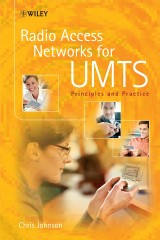Details

Radio Access Networks for UMTS
Principles and Practice2. Aufl.
|
125,99 € |
|
| Verlag: | Wiley |
| Format: | EPUB |
| Veröffentl.: | 24.08.2011 |
| ISBN/EAN: | 9781119964872 |
| Sprache: | englisch |
| Anzahl Seiten: | 648 |
DRM-geschütztes eBook, Sie benötigen z.B. Adobe Digital Editions und eine Adobe ID zum Lesen.
Beschreibungen
This book provides a comprehensive description of <i>Radio Access Networks for UMTS</i> . The main content is based upon the release 6 version of the 3GPP specifications. Changes since the release 99 version are described while some of the new features from the release 7 version are introduced. <p>Starting from the high-level network architecture, the first sections describe the flow of data between the network and end-user. This includes a dedicated chapter describing the Iub transport network. Detailed descriptions of both HSDPA and HSUPA reflect the increasing importance of efficient high data rate connections. Signalling procedures are described for speech, video and PS data connection establishment, SMS data transfer, soft handover and inter-system handover. The more practical subjects of link budgets and radio network planning are also addressed.</p> <ul type="disc"> <li>More than 180 example log files reinforce the reader's understanding</li> </ul> <ul type="disc"> <li>Summary bullet points allow rapid access to the most important information</li> </ul> <ul type="disc"> <li>Focus upon how data is transferred between the network and end-user</li> </ul> <ul type="disc"> <li>Dedicated chapters provide detailed descriptions of both HSDPA and HSUPA</li> </ul> <ul type="disc"> <li>Step-by-step analysis of common signalling procedures</li> </ul> <ul type="disc"> <li>Key radio network planning subjects addressed</li> </ul> <p><i>Radio Access Networks for UMTS</i> is ideal for mobile telecommunications engineers working for equipment vendors, operators and regulators. It will also appeal to system designers, technical managers and students.</p>
Preface. <p>Acknowledgements.</p> <p>Abbreviations.</p> <p><b>1 INTRODUCTION.</b><br /> <br /> 1.1 NETWORK ARCHITECTURE.<br /> <br /> 1.2 RADIO ACCESS TECHNOLOGY.<br /> <br /> 1.3 STANDARDISATION.<br /> <b><br /> 2 FLOW OF DATA.</b><br /> <br /> 2.1 RADIO INTERFACE PROTOCOL STACKS.<br /> <br /> 2.2 RRC LAYER.<br /> <br /> 2.3 RLC LAYER.<br /> <br /> 2.4 MAC LAYER.<br /> <br /> 2.5 FRAME PROTOCOL LAYER.<br /> <br /> 2.6 PHYSICAL LAYER.<br /> </p> <p><b>3 CHANNEL TYPES.</b><br /> </p> <p>3.1 LOGICAL CHANNELS.<br /> </p> <p>3.2 TRANSPORT CHANNELS.<br /> </p> <p>3.3 PHYSICAL CHANNELS.<br /> </p> <p><b>4 NON-ACCESS STRATUM.</b><br /> </p> <p>4.1 CONCEPTS.<br /> </p> <p>4.2 MOBILITY MANAGEMENT.<br /> </p> <p>4.3 CONNECTION MANAGEMENT.<br /> </p> <p>4.4 PLMN SELECTION.<br /> </p> <p><b>5 IUB TRANSPORT NETWORK.<br /> </b></p> <p>5.1 PROTOCOL STACKS.<br /> </p> <p>5.2 ARCHITECTURE.<br /> </p> <p>5.3 OVERHEADS.<br /> </p> <p>5.4 SERVICE CATEGORIES.<br /> </p> <p><b>6 HSDPA.<br /> </b></p> <p>6.1 CONCEPT.<br /> </p> <p>6.2 HSDPA BIT RATES.<br /> </p> <p>6.3 PDCP LAYER.<br /> </p> <p>6.4 RLC LAYER.<br /> </p> <p>6.5 MAC-D ENTITY.<br /> </p> <p>6.6 FRAME PROTOCOL LAYER.<br /> </p> <p>6.7 IUB TRANSPORT.<br /> </p> <p>6.8 MAC-HS ENTITY.<br /> </p> <p>6.9 PHYSICAL CHANNELS.<br /> </p> <p>6.10 MOBILITY.<br /> </p> <p><b>7. HSUPA.</b><br /> </p> <p>7.1 CONCEPT.<br /> </p> <p>7.2 HSUPA BIT RATES.<br /> </p> <p>7.3 PDCP LAYER.<br /> </p> <p>7.4 RLC LAYER.<br /> </p> <p>7.5 MAC-D ENTITY.<br /> </p> <p>7.6 MAC-ES/E ENTITY (UE).<br /> </p> <p>7.7 PHYSICAL CHANNELS.<br /> </p> <p>7.8 MAC-E ENTITY (NODE B).<br /> </p> <p>7.9 FRAME PROTOCOL LAYER.<br /> </p> <p>7.10 MAC-ES ENTITY (RNC).<br /> </p> <p>7.11 MOBILITY.<br /> </p> <p><b>8 SIGNALING PROCEDURES.</b><br /> </p> <p>8.1 RRC CONNECTION ESTABLISHMENT.<br /> </p> <p>8.2 SPEECH CALL CONNECTION ESTABLISHMENT.<br /> </p> <p>8.3 VIDEO CALL CONNECTION ESTABLISHMENT.<br /> </p> <p>8.4 SHORT MESSAGE SERVICE (SMS).<br /> </p> <p>8.5 PS DATA CONNECTION ESTABLISHMENT.<br /> </p> <p>8.6 SOFT HANDOVER.<br /> </p> <p>8.7 INTER-SYSTEM HANDOVER.<br /> </p> <p><b>9 PLANNING.<br /> </b></p> <p>9.1 LINK BUDGETS.<br /> </p> <p>9.2 RADIO NETWORK PLANNING.<br /> </p> <p>9.3 SCRAMBLING CODE PLANNING.<br /> </p> <p>9.4 NEIGHBOUR PLANNING.<br /> </p> <p>9.5 ANTENNA SUB-SYSTEMS.<br /> </p> <p>9.6 CO-SITING.<br /> </p> <p>9.7 MICROCELLS.<br /> </p> <p>9.8 INDOOR SOLUTIONS.<br /> </p> <p>10 REFERENCES.</p> <p>Index</p>
<b>Chris Johnson</b> has worked with UMTS networks for the past ten years and has worked for Nokia Siemens Networks for the past seven years. He is currently a Principle Engineer at NSN and is based in the UK.
This book provides a comprehensive description of <i>Radio Access Networks for UMTS</i> . The main content is based upon the release 6 version of the 3GPP specifications. Changes since the release 99 version are described while some of the new features from the release 7 version are introduced. <p>Starting from the high-level network architecture, the first sections describe the flow of data between the network and end-user. This includes a dedicated chapter describing the Iub transport network. Detailed descriptions of both HSDPA and HSUPA reflect the increasing importance of efficient high data rate connections. Signalling procedures are described for speech, video and PS data connection establishment, SMS data transfer, soft handover and inter-system handover. The more practical subjects of link budgets and radio network planning are also addressed.</p> <ul> <li>More than 180 example log files reinforce the reader's understanding</li> </ul> <ul> <li>Summary bullet points allow rapid access to the most important information</li> </ul> <ul> <li>Focus upon how data is transferred between the network and end-user</li> </ul> <ul> <li>Dedicated chapters provide detailed descriptions of both HSDPA and HSUPA</li> </ul> <ul> <li>Step-by-step analysis of common signalling procedures</li> </ul> <ul> <li>Key radio network planning subjects addressed</li> </ul> <p><i>Radio Access Networks for UMTS</i> is ideal for mobile telecommunications engineers working for equipment vendors, operators and regulators. It will also appeal to system designers, technical managers and students.</p>


















